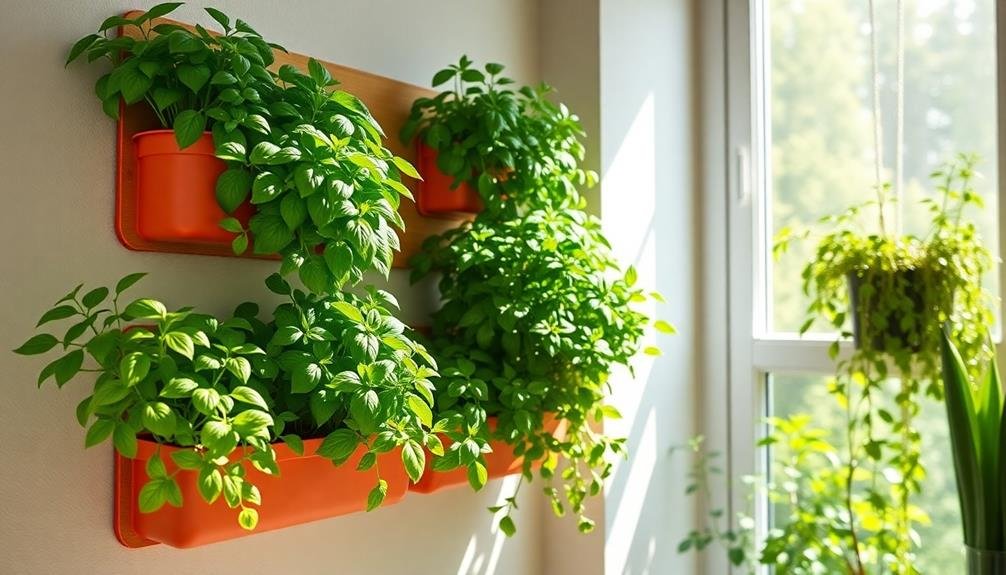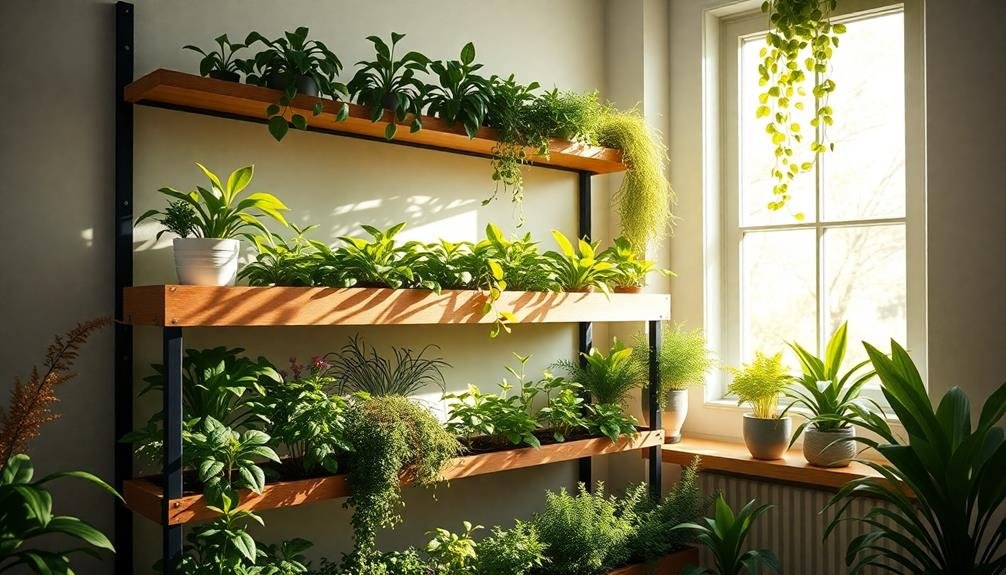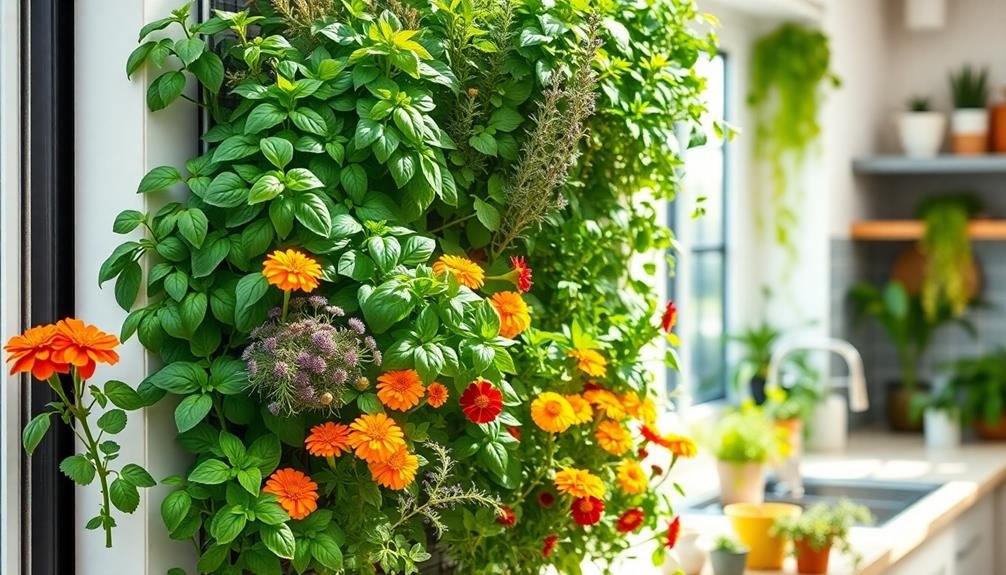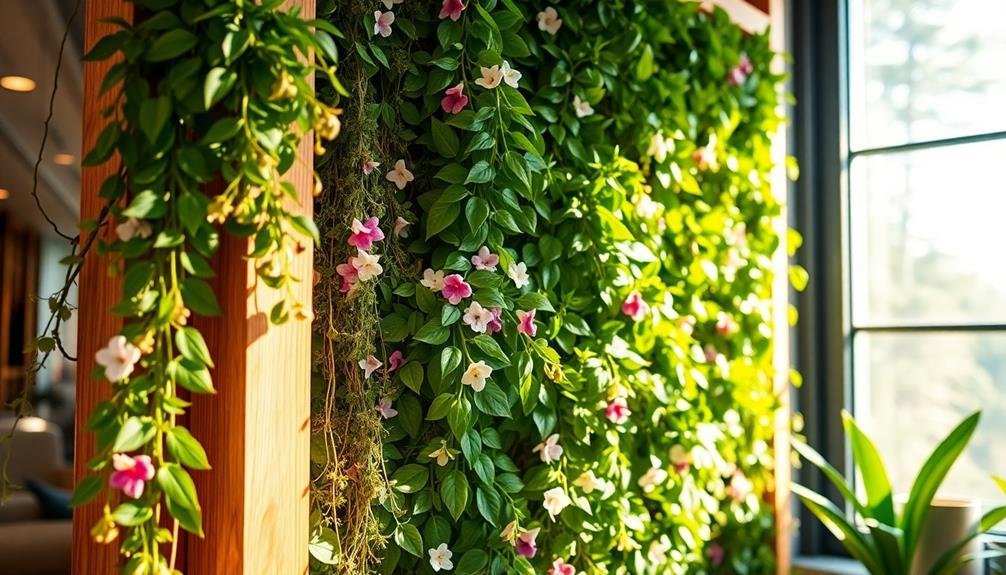Indoor vertical herb gardens are perfect for growing fresh tea herbs, especially when space is tight. These setups help you maximize your growing area while creating a beautiful green display. You can choose from wall-mounted planters, freestanding shelves, or even DIY pallet gardens. Popular herbs for tea, like mint and chamomile, thrive well in these conditions. Just remember to provide adequate light, water, and nutrients to keep your plants healthy. By adopting these solutions, you'll not only enjoy fresh tea but also enhance your indoor decor. Keep exploring for more tips on maintaining and harvesting your indoor herb garden!
Benefits of Vertical Herb Gardens

Vertical herb gardens offer numerous benefits that make them an ideal choice for indoor gardening enthusiasts.
First off, they save space. If you're short on room, a vertical setup allows you to grow multiple herbs without taking up valuable floor space. You can easily mount a vertical garden on any wall, transforming a plain area into a lush green display.
Another advantage is accessibility. With herbs within arm's reach, you can quickly snip fresh leaves right when you need them for cooking or tea. This convenience encourages you to use more fresh ingredients, enhancing your meals and beverages.
Additionally, vertical gardens often improve air circulation and light exposure for your plants. By positioning herbs vertically, you maximize sunlight, helping them thrive even in low-light conditions. This setup can also create a visually appealing focal point in your home, adding both beauty and freshness to your decor.
Lastly, vertical herb gardens promote better water drainage. With proper construction, excess water can flow away easily, reducing the risk of root rot.
Choosing the Right Herbs
When choosing herbs for your indoor vertical garden, think about which ones thrive best in your space.
Consider their growth requirements and care routines, as some herbs need more light and attention than others.
Best Herbs for Indoors
Choosing the right herbs for your indoor garden can transform your cooking and elevate your home's ambiance. When selecting herbs, contemplate your culinary preferences and the space you have available. Some of the best herbs for indoor gardening include basil, parsley, cilantro, and mint.
Basil thrives in warm conditions and adds a delightful flavor to pasta dishes and salads. Its fragrant leaves can also elevate your home's scent.
Parsley is versatile and easy to grow, perfect for garnishing or adding to recipes. Cilantro, with its distinct flavor, is ideal for salsas and Asian dishes, making it a must-have for spice enthusiasts.
Mint is another excellent choice, as it grows vigorously and can be used in teas, desserts, or cocktails. Additionally, you might want to contemplate chives, which offer a mild onion flavor and can be snipped fresh for salads and soups.
When choosing herbs, think about how often you'll use them in your cooking. Opt for a mix of flavors and textures to create a vibrant, functional indoor garden that enhances your culinary adventures and livens up your living space.
Growth Requirements and Care
To nurture your indoor herb garden successfully, you'll need to understand each herb's specific growth requirements and care needs.
Start by choosing herbs that thrive in indoor conditions, such as basil, mint, and parsley. Each of these herbs prefers different light levels; basil loves bright, direct sunlight, while mint does well in partial shade.
Watering is another key factor. Most herbs need evenly moist soil but avoid waterlogging, which can lead to root rot. Check the top inch of soil; if it feels dry, it's time to water.
Fertilizing is essential, too. Use a balanced, water-soluble fertilizer every four to six weeks to promote healthy growth.
Pay attention to your herbs' growth patterns; if they become leggy or pale, it may indicate a need for more light or nutrients.
Ideal Indoor Growing Conditions

Creating ideal indoor growing conditions for your vertical tea herb garden is important for thriving plants.
First, you'll want to choose a location with plenty of natural light. Aim for at least 6-8 hours of indirect sunlight each day. If your space lacks sufficient light, consider using grow lights to supplement.
Next, pay attention to temperature and humidity. Most tea herbs prefer a temperature range between 65°F and 75°F. Keep your garden away from drafts and heating vents to maintain a stable environment.
Humidity is also essential; aim for 40-60% humidity levels. You can achieve this by misting your plants or using a small humidifier.
Watering is critical, but it's important not to overdo it. Check the soil moisture regularly, and water only when the top inch feels dry. Good drainage is key—ensure your vertical garden has proper drainage holes to prevent root rot.
Lastly, consider using a quality potting mix. Look for a blend specifically designed for herbs that provides good aeration and drainage.
Selecting Vertical Garden Designs
When selecting a vertical garden design, you'll want to contemplate the types of vertical gardens available and the materials you'll use for construction.
Each type offers unique benefits, and the right materials can enhance both aesthetics and functionality.
Let's explore your options to create the perfect indoor herb garden.
Types of Vertical Gardens
Among the myriad options available, selecting the right design for your vertical garden can greatly enhance your indoor herb and tea garden experience.
When you think about vertical gardens, consider wall-mounted planters. These are perfect for small spaces, allowing you to hang pots or containers directly on your walls, creating a stunning visual display.
Another option is the freestanding vertical garden. This design uses shelves or tiered systems that occupy floor space but also provide ample planting opportunities. It's a great choice if you want mobility or flexibility in your garden layout.
You might also explore pocket planters, which are fabric or felt structures with pockets for planting. They're lightweight, easy to maintain, and can be hung on walls or fences, ideal for herbs that love drainage.
If you're feeling creative, consider a DIY pallet garden. Repurposing wooden pallets not only saves money but also lets you customize the size and layout according to your available space.
Finally, don't overlook hydroponic systems, which can provide nutrient-rich environments for your herbs while saving water.
Choose a design that fits your style and space, and watch your indoor garden flourish!
Materials for Construction
Selecting the right materials for your vertical garden can greatly impact its durability and overall aesthetic. When constructing your indoor tea herb garden, consider using lightweight options like PVC, which is durable and resistant to moisture.
Wood can add a natural touch, but be sure to choose rot-resistant types like cedar or redwood to guarantee longevity.
For the growing containers, opt for fabric pots or recycled plastic planters. Fabric pots promote better drainage and aeration, helping your herbs thrive.
If you're feeling creative, consider upcycling materials like old pallets or crates, giving your garden a unique look while being eco-friendly.
Don't forget about the framework. A sturdy metal or wooden frame can support your plants effectively. Use stainless steel or galvanized materials to resist rust and wear.
Lastly, think about irrigation. Drip systems or self-watering mechanisms can simplify maintenance and guarantee your herbs receive consistent hydration.
DIY Vertical Planter Ideas

Creating your own vertical planters can transform any indoor space into a lush herb garden with just a few simple materials. One popular idea is to use wooden pallets. You can easily repurpose a pallet by leaning it against a wall and filling the slats with potting soil and your favorite herbs. This not only saves space but also adds a rustic charm to your home.
If you're looking for something more modern, consider using vertical planters made from stacked terra cotta pots. Simply stack them in a pyramid formation, securing each pot with wire. This design allows you to grow multiple herbs while keeping them easily accessible.
Another option is to use hanging shoe organizers. You can hang one on a door or wall and fill each pocket with soil and herbs. It's an efficient way to maximize vertical space while keeping your herbs organized and within reach.
Lastly, you can create a vertical garden frame using a wooden trellis. Attach small pots to the trellis with hooks or ties, and you'll have an eye-catching herb display that brings life to any room.
With these DIY ideas, you'll be on your way to enjoying fresh herbs right at home!
Soil and Nutrient Requirements
To guarantee your indoor vertical tea herb garden thrives, understanding soil and nutrient requirements is vital. The right soil mix will provide adequate drainage while retaining moisture, which is essential for healthy root development. Aim for a quality potting mix designed for herbs, as it typically contains the ideal balance of ingredients.
Here are key components to take into account for peak growth:
- pH Level: Aim for a slightly acidic to neutral pH (6.0 to 7.0) to promote nutrient uptake.
- Organic Matter: Incorporate compost to enrich the soil, supplying essential nutrients and improving texture.
- Nutrients: Use a balanced, slow-release fertilizer to guarantee your herbs receive a steady supply of nutrients throughout their growth cycle.
- Drainage: Ascertain your containers have sufficient drainage holes to prevent waterlogging, which can lead to root rot.
Watering Techniques for Herbs

Watering your herbs is essential for their health and productivity, especially in an indoor vertical garden where conditions can vary. To guarantee your herbs thrive, start by checking the moisture level of the soil. Stick your finger about an inch deep; if it feels dry, it's time to water.
When you water, do so thoroughly. Pour water until it drains out of the bottom of the pot. This guarantees that the roots get adequate moisture and helps prevent root rot by encouraging proper drainage. Use room temperature water to avoid shocking the plants.
Consider using a watering can with a long spout or a spray bottle for precision, especially in tight spaces. If you're using a drip tray, be cautious of overwatering, as stagnant water can lead to fungal issues.
Automatic watering systems can also be beneficial for busy schedules. They help maintain a consistent moisture level, but be sure to monitor for any signs of overwatering.
Light Sources for Indoor Gardens
When growing your indoor vertical tea herb garden, light is essential for healthy plants.
You'll want to take into account both natural light sources and artificial lighting options to guarantee your herbs thrive.
Plus, understanding the right duration of light exposure can make all the difference in your garden's success.
Natural Light Considerations
Natural light plays an essential role in the success of your indoor vertical tea herb garden, as it directly influences plant growth and health. To maximize the benefits of natural light, you'll want to take into account a few key factors.
First, assess the light quality and duration in your space. Most tea herbs thrive with at least 6 hours of direct sunlight daily, so positioning your garden near a south-facing window is ideal.
If that's not possible, keep these tips in mind:
- Rotate your plants: Regularly turn your pots to guarantee all sides receive equal light exposure.
- Use reflective surfaces: Position mirrors or light-colored walls nearby to bounce sunlight onto your plants.
- Monitor seasonal changes: Be aware that light intensity and duration can vary with the seasons, so adjust your setup as needed.
- Observe your plants: Watch for signs of light stress, like leggy growth or yellowing leaves, and reposition accordingly.
Artificial Lighting Options
If you've found yourself struggling to provide enough sunlight for your indoor vertical tea herb garden, it might be time to look into artificial lighting options.
Using the right light sources can make a significant difference in your plants' growth and health.
LED grow lights are among the most popular choices for indoor gardens. They're energy-efficient, long-lasting, and produce minimal heat, which means you can place them closer to your plants without the risk of burning them.
Look for full-spectrum LEDs that mimic natural sunlight, providing the broad wavelength range your herbs need.
Fluorescent lights, particularly T5 tubes, are also effective and budget-friendly. These lights emit less heat than incandescent bulbs and cover a larger area, making them suitable for vertical gardens.
If you're considering incandescent bulbs, be cautious. While they're widely available and cheap, they generate too much heat and can waste energy.
Lastly, think about positioning your lights. Ideally, you should place them about 12 to 24 inches above your plants, adjusting as they grow.
With the right artificial lighting, your indoor vertical tea herb garden can thrive, even without natural sunlight.
Light Duration Guidelines
Proper light duration is just as important as the type of light you choose for your indoor vertical tea herb garden. Ensuring your plants receive the right amount of light can greatly impact their growth, flavor, and overall health.
Most tea herbs thrive with around 12 to 16 hours of light each day. Here's how you can effectively manage light duration for your garden:
- Observe Plant Behavior: Watch how your herbs respond. If they're stretching towards the light, they might need more exposure.
- Use Timers: Consider investing in timers for your grow lights. This way, you can maintain a consistent light schedule effortlessly.
- Adjust Seasonally: Be mindful of seasonal changes. In winter, you might need to increase light duration as days get shorter.
- Monitor Light Intensity: If your herbs show signs of burning or fading, you may need to adjust the intensity or distance of your light source.
Companion Planting for Flavor

Companion planting can elevate the flavors of your indoor vertical tea herb garden by strategically pairing herbs that enhance each other's growth and taste.
When you plant herbs like basil and oregano together, basil can improve the flavor profile of the oregano, making your tea blends even more aromatic and delicious.
Consider combining mint with chamomile. The mint's invigorating essence can complement chamomile's soothing qualities, creating a delightful herbal infusion.
Rosemary and thyme also make a great duo; their robust flavors can enrich your culinary dishes and teas alike.
Don't forget about the importance of spacing. Make certain each plant has enough room to thrive, as overcrowding can lead to stunted growth and diminished flavor.
Herbs like cilantro and dill can coexist well, but they'll need adequate separation to prevent competition for nutrients.
Maintaining Your Herb Garden
Maintaining your herb garden requires consistent attention to water, light, and nutrients to keep your plants thriving.
Start by making sure your herbs receive adequate sunlight—most herbs need about six hours of light each day. If natural light is limited, consider using grow lights to supplement.
Water your herbs carefully; overwatering can lead to root rot while underwatering can stunt growth. Always check the soil moisture before adding more water.
Additionally, don't forget to feed your herbs with a balanced fertilizer every few weeks to provide them with essential nutrients.
Here are some quick tips to help you maintain your indoor herb garden:
- Rotate Plants: Rotate your pots occasionally to make sure all sides receive equal light exposure.
- Prune Regularly: Trim dead leaves and pinch back growth to promote bushiness and enhance flavor.
- Monitor Pests: Keep an eye out for pests like aphids or spider mites. Treat infestations promptly to prevent damage.
- Adjust Temperature: Maintain a consistent indoor temperature, ideally between 65-75°F, to foster ideal growth.
Harvesting and Storing Herbs

Harvesting your herbs at the right time is essential for maximizing flavor and potency. You'll want to pick your herbs just before they start to flower, as this is when their oils and flavors are at their peak. Use sharp scissors or pruning shears to snip off the leaves or stems, making clean cuts that won't damage the plant.
Aim to harvest in the morning after the dew has dried but before the sun is too hot.
Once you've collected your herbs, it's vital to store them properly to maintain their freshness. You can hang them upside down in a cool, dark, and well-ventilated area to dry. Alternatively, you can use a dehydrator or an oven set to the lowest temperature.
After they're dried, crumble the leaves and store them in airtight containers away from light and moisture.
If you prefer to freeze your herbs, chop them and place them in ice cube trays filled with water or oil. This method preserves their vibrant color and flavor, ensuring you can enjoy your homegrown herbs long after harvest.
With these techniques, you'll always have fresh herbs on hand for your culinary creations.
Creating Herbal Tea Blends
Creating herbal tea blends can be a rewarding experience, allowing you to customize flavors and health benefits to suit your taste. Start by selecting a base herb, like chamomile or peppermint, which will serve as the foundation of your blend.
Then, layer in other herbs for added depth, such as lemon balm for a citrusy note or hibiscus for a tart twist.
Consider these key points while crafting your blends:
- Flavor Profile: Think about how different herbs will complement each other. Balance sweet, spicy, and bitter notes to create a harmonious blend.
- Health Benefits: Research the health properties of your chosen herbs. For instance, ginger can aid digestion, while lavender may promote relaxation.
- Experimentation: Don't hesitate to try unexpected combinations. You might discover a unique blend that becomes your new favorite.
- Proportions: Start with small amounts and adjust as needed. A good rule of thumb is to use two parts base herb to one part additional herbs.
Frequently Asked Questions
Can I Use Recycled Materials for Vertical Planters?
Absolutely, you can use recycled materials for vertical planters! Old pallets, bottles, or tin cans work great. Just make sure they're clean and safe for your plants, and you'll create an eco-friendly garden in no time!
How Do I Prevent Pests in Indoor Gardens?
To prevent pests in your indoor garden, regularly inspect your plants, maintain cleanliness, and use natural repellents. Encourage beneficial insects and guarantee good air circulation; these steps will help keep your plants healthy and pest-free.
What Tools Do I Need for Vertical Gardening?
For vertical gardening, you'll need essential tools like sturdy containers, trellises, potting soil, watering cans, and pruning shears. Don't forget to grab plant food and a light meter to guarantee your plants thrive.
Are There Any Herbs That Require Special Care?
Some herbs, like basil and cilantro, need more attention. They thrive with consistent watering and appropriate sunlight. You'll find that others, such as mint, can be a bit more resilient, needing less care overall.
How Do I Ensure Proper Drainage in Vertical Planters?
To guarantee proper drainage in vertical planters, you should use materials like gravel or rocks at the bottom. Also, make certain your planters have drainage holes, and avoid overwatering your plants to prevent root rot.
In Summary
Incorporating a vertical herb garden into your home not only saves space but also enhances your culinary experience. By choosing the right herbs and providing ideal growing conditions, you can create a flourishing indoor oasis. With DIY planter ideas and tips on companion planting, you'll maximize flavor and freshness. Remember to maintain your garden and explore the joy of harvesting and blending your own herbal teas. Start your journey to a vibrant, aromatic space today!





Leave a Reply